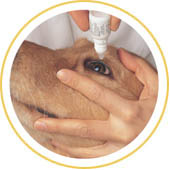Eye Care | Dog care info
| A healthy dog’s eyes should be clear, bright and free from dirt, discharge and inflammation. Common Symptoms of Illness
Eye Tests used to Diagnose Eye Problems
|
|
Common Eye Conditions & Symptoms
 Conjunctivitis is an inflammation of the membrane that covers both the inner lining of the eyelid and the white of the eye. It may be caused by infections, allergies, inadequate tear production or irritation.
Conjunctivitis is an inflammation of the membrane that covers both the inner lining of the eyelid and the white of the eye. It may be caused by infections, allergies, inadequate tear production or irritation.
Keratoconjunctivitis Sicca (DRY EYE) occurs when the tear glands do not produce enough tears. This results in recurrent or chronic conjunctivitis - persistently sore eyes - and, untreated, may eventually lead to blindness. Certain breeds, such as West Highland White Terriers, Cavalier King Charles and Cocker Spaniels, seem to be more prone to this problem, though any dog may be affected.
Visit www.dog-dry-eye.com for more information.
Corneal Ulceration can occur when the shiny surface of the cornea is scratched or damaged.
Epiphora. If your dog’s eye constantly 'weeps', or if the fur around it appears 'stained', the normal tear flow may be blocked.
Cataracts & Glaucoma. Dogs, just like humans, can have these serious eye diseases. Cataracts cloud the lens inside the eye and are the most common cause of canine blindness. A hereditary condition in some breeds, early examination by your veterinary surgeon is important, as such animals should not be bred. Glaucoma stems from too much pressure being exerted upon the eye’s interior as a result of a decrease in the amount of fluid draining from it.
How to Administer Eye Drops
 You may need to muzzle your dog.
You may need to muzzle your dog.- Remove any discharge around the eye with a cotton ball moistened with warm water.
- See the instructions on the bottle for dosage. Shake if necessary.
- Use one hand to hold the bottle between thumb and index and place the other under your dog’s jaw to support the head.
- Tilt the head back and, to prevent blinking, use your free fingers to hold the eyelids open.
- Hold the bottle close to the eye but DON’T touch the eye’s surface.
- Squeeze the drops onto the eye and once the drops are in, release the head.
- Your dog will blink, spreading the medication over the eye’s surface.
How to Apply Eye Ointment
 You may need to muzzle your dog.
You may need to muzzle your dog.- Remove any discharge around the eye with a cotton ball moistened with warm water.
- Check the instructions on the tube for dosage.
- Gently pull back upper and lower eyelids.
- Holding the tube parallel to the lower eyelid, squeeze the ointment on to its edge. DON’T let the tube touch the eye’s surface.
- Lightly massage upper and lower eyelids together to spread the medication.
- Release the head. Let your dog blink.


